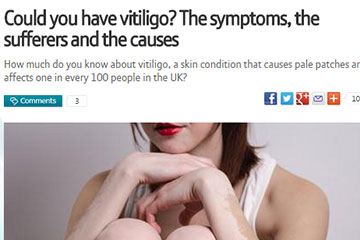
Could you have vitiligo? The symptoms, the sufferers and the causes
DERMATOLOGY
BT Lifestyle
Just as people can develop darker patches of skin, where there’s an abundance of pigmentation, the opposite can happen too, where a loss of pigmentation results in noticeably pale, white patches.
The medical name for this is vitiligo, and it affects around one in every 100 people in the UK.
Michael Jackson reportedly had it, and Most Haunted presenter Yvette Fielding has previously talked about the impact of her vitiligo.
Want to know more, or are you concerned you could have it? Read on for some key facts about vitiligo
Who gets vitiligo?
Anybody can get it, and while it usually begins before the age of 20, vitiligo can develop at any age.
Dr Noor Almaani, a dermatologist at The Private Clinic of Harley Street, adds: “The risk is increased if a person comes from a family with a history of autoimmune diseases, such as [type 1] diabetes or a thyroid disease.”
Will the patches spread?
“The severity of vitiligo can vary,” says Almaani.
“In some instances, it can be found in localised areas such as around the eyes, nose and mouth, whereas in others it can be very extensive and cover large areas of the body.”
There are different types of vitiligo too. The two most common are non-segmental vitiligo, which usually means symmetrical patches affecting areas like the hands, knees and elbows, and segmental vitiligo which tends to affect one area of the body.
It’s also thought that things like sun exposure and stress could, in some cases, make vitiligo worse.
Is it serious?
While not generally classed as serious, there are things to take into consideration with vitiligo. Patches with no pigmentation will be more vulnerable to sun damage, so it’s important to use a high SPF when these areas are exposed.
Also, vitiligo can potentially affect anywhere there’s usually pigmentation, including the hair and eyes, and it can sometimes lead to partial hearing loss (hypoacusis).
Often the biggest challenge with vitiligo, as with many other skin conditions, is psychological.
What are the treatment options?
Treatments can help improve the appearance of vitiligo, but there’s no long-term cure, as is the case for the vast majority of conditions.
“Vitiligo can be treated, however it’s important to note that, even after treatment, it is likely to reoccur throughout a person’s life,” says Almaani.
“Treatments include topical creams such as steroid cream, Calcineurin inhibitors [drugs that inhibit the action of calcineurin, an enzyme involved in activating the T-cells of the immune system], and photo therapy treatment which can help to produce pigmentation.”
Camouflage make-up can also be helpful.
I might have it, what should I do?
If you think you could have vitiligo, it’s best to see your GP or dermatologist for a proper diagnosis. If necessary, you could also be referred for tests to check for co-existing auto-immune conditions, and a health professional can advise on treatment options and sun safety, as well as psychological support.




